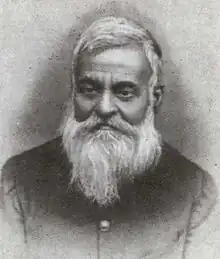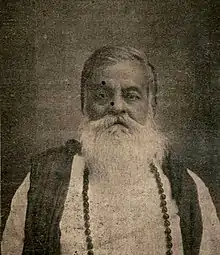Troilokyanath Mukhopadhyay
Trailokyanath Mukhopadhyay or T. N. Mukharji in British Indian Government records (Bengali: ত্রৈলোক্যনাথ মুখোপাধ্যায়, Troilōkyanātha Mukhōpādhyāẏa) (22 July 1847 – 3 November 1919) was an Indian public servant who served as a curator of the Indian Museum at Calcutta, and was a renowned author who wrote both in English and Bengali. He was in-charge of organizing exhibits for the Calcutta International Exhibition of 1883, the Amsterdam Exhibition in the same year, the 1886 Colonial and Indian Exhibition, and the 1888 Glasgow International Exhibition. His travels in Europe as part of this was published as a popular travelogue A Visit to Europe (1889).
Trailokyanath Mukherjee | |
|---|---|
 Troilokyanath Mukhopadhyay | |
| Born | 22 July 1847 Rahuta, 24 Parganas, Bengal Presidency,Company Raj (now in North 24 Parganas, West Bengal, India) |
| Died | 3 November 1919 (aged 72) |
| Occupation | public servant, curator of the Indian Museum, writer |
| Period | 1888–1919 |
| Genre | Novel, short story |
| Notable works | Kankabati Bhoot O Manush Damru Charit |
| Relatives | Vishwambhar Mukherjee (father) |
Life

Trailokyanath was born in the village of Rahuta,[1] near Shyamnagar in the North 24 Parganas district of West Bengal. Attending school in Hugli-Chuchura and Bhadreswar but largely self-taught, he became a school teacher in Daroka (Birbhum), Ukhra, Raniganj and in Sahajadpur, Sirajganj. From 1868 he served as a police sub-inspector in Cuttack (1868). Having learned Oriya, he joined Bhagavati Charan Das's Utkal Subhakari as editor. Later meeting Sir William Hunter, the compiler of A Statistical Account of Bengal (which historically included modern Bangladesh, West Bengal, Bihar and Orissa), he joined the Bengal Gazetteer Office as a clerk (1870). He became a chief clerk in the Agriculture Department and rose to become its assistant director, before joining the Government of India revenue department (1881). He helped in organizing the exhibits for the Calcutta International Exhibition of 1883. From 1886 he was assistant curator of the Indian Museum in Calcutta. In 1896 he retired on a pension.
During India's Great Famine of 1876–78, which had been aggravated by Viceroy Lytton's policy of exporting Indian wheat and other cash crops, Troilokyanath advised the government that it could save many lives by promoting the cultivation of carrots; the policy was adopted in the Raebareli and Sultanpur districts of Uttar Pradesh.[2] F. N. Wright notes: "How wonderfully life was preserved in our upper districts by the extension of carrot cultivation, and how important it is to introduce crops (1) which do not fail under the same conditions as the staple crops of the country, and (2) which give a substantial fodder supply in the cold and dry months. Our chief expectations this direction rest upon (1) lucerne in irrigated tracts, mangelwurzel" — a type of beet grown mainly for animal feed — and "(3) extension of the cultivation of carrots, potatoes and other root crops to districts where they are little known."[2]
Literary career
Trailokyanath Mukhopadhyay was a famous writer, one of the pioneers of secular Bengali literature. One of his most famous works is Damru Charit (Bengali: ডমরু-চরিত) a collection of humorous and satirical short stories published posthumously in 1923. The stories, set in colonial India, recount the life and times of the antihero Damrudhar, portrayed as a dishonest man who rises from a lowly shop-assistant to a landowner.
Together with Nagendranath Basu, Trailokyanath compiled the first volume of Bangla Bishwakosh (Bengali: বাঙলা বিশ্বকোষ), a Bengali-language encyclopedia; Nagendranath completed the remaining 22 volumes.
Some of Trailokyanath Mukhopadhyay’s short stories are translations/adaptations of English fictions. These include “Pithe Parbane Chine Bhut “ (Bengali: পিঠে পার্বণে চীনে ভূত) (adaptation of Sir Arthur Conan Doyle’s The Brown Hand), “Bhuter Bari” (Bengali: ভূতের বাড়ি) (adaptation of Sir Edward Bulwer-Lytton’s “The Haunted and the Haunters: or the House and the Brain”) and “Pujar Bhut” (Bengali: পূজার ভূত) (adaptation of Mrs Elizabeth Gaskell’s “The Old Nurse’s Story).[3]
An English translation of several of his stories is published as Of Ghosts and Other Perils (Arnab Bhattacharya, trans., 2013: Orient Blackswan, 288 pages. ISBN 978-8125052340). That book includes Birbala, Lullu, Nayanchand’s Business, The Pearl Necklace, Smile on Madan Ghosh’s Face, A Story by Damrudhar and Another Story by Damrudhar.[4]
Selected works
- Art-manufactures of India (1888)
- A Visit To Europe (1902)
- Hand-book of Indian Products (Art-manufactures and Raw Materials) (1883)
- কঙ্কাবতী (Kaṅkābatī, 1892)
- ভুত ও মানুষ (Bhoot O Manush, 1896)
- ফোকলা দিগম্বর (Fokla Digombor 1900)
- মুক্তা-মালা (Muktā-mālā, The Pearl Necklace, 1901)
- A visit to Europe (1902)
- ভারতবর্ষীয় বিজ্ঞান সভা (Bharatbarshio Bigyan Sobha 1903)
- ময়না কোথায় (Moina Kothai, 1904)
- মজার গল্প (Mojar Golpo, 1905)
- পাপের পরিনাম (Paper Porinam,1908)
- বীরবালা (Bīrabālā, Birbala)
- লুল্লু (Lullu, Lullu)
- নয়নচাঁদের ব্যবসা (Naẏanacām̐dēra byabasā, Nayanchand’s Business)
- রাজভক্তিসার (Rajbhakti-shar, The Quintessence of Devotion towards the Crown, 1918–19) [5]
- ডমরু-চরিত (Ḍamaru-carita, Damru Charit, 1923)
References
- 2011 Census: Rahuta Population - North 24 Parganas, West Bengal
- F. N. Wright, Administration report by United provinces of Agra and Oudh, 1880, Department of Agriculture and Commerce, N.W. Provinces and Oudh, page 25.
- Representations of Ghosts in Trailokyanath's Writings: A Reassessment, by Biswajit Das and Ayusman Chakraborty, The Criterion: An International Journal in English, volume 11, issue IV, August 2020.
- Ketaki Datta, Book Review: Of Ghosts and Other Perils by Troilokyanath Mukhopadhyay, Rupkatha Journal on Interdisciplinary Studies in Humanities (ISSN 0975-2935), Vol. VI, No. 3, 2014.
- Trailokyanath and Rajbhakti: The Quintessence of Devotion towards the Crown, by Ayusman Chakraborty, Appropriations, volume 9, December 2013.